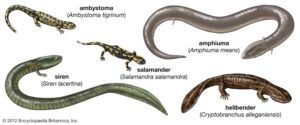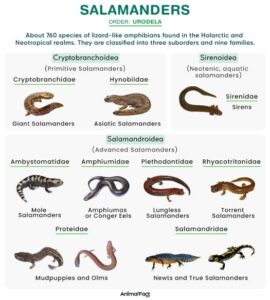Back to: ZOOLOGY 300 Level
Welcome To Class!
Hey there, my brilliant friend! I’m glad to see you today — ready to learn, ready to grow. Just like how animals have evolved and changed over time, you too are evolving every day into the best version of yourself. Today, let’s talk about one of the most important steps in the story of life on Earth — the evolution from amphibians. It’s a fascinating journey, and by the end of this lesson, you’ll see how everything is connected — even that frog that croaked outside your window last night!
Evolution From Amphibians
What are Amphibians?
Amphibians are those wonderful animals that can live both in water and on land — a bit like someone who grew up in the village and now comfortably lives in Lagos city, still able to go back home and adjust easily. Frogs, toads, and salamanders are examples. They have smooth, moist skin and start life in water as eggs, which hatch into larvae (like tadpoles) before they grow into adults that can live on land.

Millions of years ago, amphibians evolved from lobe-finned fishes — these fishes had sturdy fins that looked a bit like limbs and could help them move in shallow waters or muddy environments. Imagine a fish trying to crawl like a baby on all fours — that’s how nature began to shape amphibians.
Why Did Amphibians Begin Living on Land?
One big reason was that life in water became tough. Water bodies would dry up during certain seasons, and predators were everywhere. So, animals that could breathe air and crawl over land had an advantage — they could escape danger and find new places to live. It’s like when someone moves from a noisy, unsafe area in the city to a quieter, more peaceful town.
Also, the land had something new: insects and plants — fresh sources of food! Amphibians that could survive on land could eat well, grow stronger, and pass on their helpful features to their babies.
What Changes Helped Amphibians Evolve Further?
To live successfully on land, amphibians had to develop new features. Over time, these features became even more advanced in the animals that came after them — especially reptiles.
- Lungs became better at breathing air.
- Limbs got stronger and more supportive.
- Skin started becoming less dependent on moisture.
- Eggs in reptiles became covered with shells so they didn’t need water to develop.
Think of it like upgrading from a simple rechargeable lamp to a full solar system — more independence from external sources.
How Did Amphibians Lead to Reptiles?

Some amphibians gave rise to creatures that could stay on land completely. These animals no longer needed to go back to the water to lay eggs. Their skin was drier, their bodies more adapted to land life. These were the first reptiles — the next step in evolution. From reptiles, we later got birds and mammals, including you and me.
It’s like how a family that once only knew how to fish eventually learns to farm and then starts selling their produce in the market — progress over time!
Summary
- Amphibians evolved from lobe-finned fish and could live both in water and on land.
- Dry environments and new food sources pushed amphibians to adapt to land.
- Important changes included stronger lungs, limbs, and skin, as well as new egg adaptations.
- Reptiles evolved from amphibians and were better suited for full land life.
Evaluation
- Explain how amphibians are linked to both water and land environments.
- Why did amphibians need to develop lungs and limbs?
- What features made reptiles more suited to land life compared to amphibians?
- Describe how the life cycle of a frog gives clues about evolution.
You’ve done excellently well today! Your mind is growing stronger with each lesson, and I’m proud of you. Remember, your learning journey is just like evolution — steady, powerful, and always moving forward. Afrilearn is always here to support your greatness. Can’t wait to see you in the next class!
